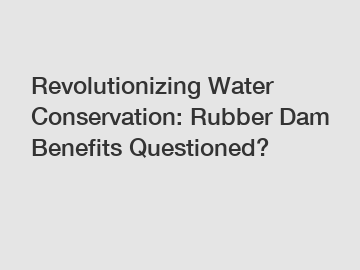Feb. 27, 2024
Environment
Water conservation is a critical issue that affects us all. With growing concerns about water scarcity and climate change, finding innovative solutions to manage our water resources is more important than ever. One such solution that has gained popularity in recent years is the use of rubber dams.
Rubber dams are inflatable barriers placed across a river or waterway to control the flow of water. They are typically made of reinforced rubber and are filled with air or water to create a temporary barrier. The main purpose of rubber dams is to raise the water level upstream, creating a reservoir effect that can be used for irrigation, hydroelectric power generation, flood control, or recreational purposes.
At first glance, rubber dams seem like a revolutionary way to conserve water. They are relatively easy to install and can be customized to fit the specific needs of a particular site. They also have the advantage of being temporary, which means they can be removed or adjusted as needed.

However, despite their potential benefits, the use of rubber dams has come under scrutiny in recent years. Critics argue that the environmental impact of rubber dams may outweigh their benefits. One of the main concerns is the potential disruption of aquatic ecosystems. By altering the flow of water, rubber dams can negatively impact fish migration, water quality, and the overall health of the ecosystem.
In addition, there are concerns about the long-term durability of rubber dams. Since they are made of rubber, they are subject to wear and tear over time, especially in harsh environmental conditions. This raises questions about the sustainability of rubber dams as a long-term water conservation solution.
Another issue that has been raised is the cost-effectiveness of rubber dams. While they may be cheaper to install initially compared to other water management systems, the ongoing maintenance costs can add up over time. This raises important questions about the feasibility of using rubber dams as a sustainable water conservation solution in the long run.
Despite these concerns, there are still proponents of rubber dams who argue that when used correctly, they can be an effective tool for water conservation. They point to successful projects where rubber dams have been used to create reservoirs for irrigation or generate renewable energy.
So, what is the verdict on rubber dams? Are their benefits truly worth questioning? The answer is not so clear-cut. Like many water management solutions, rubber dams have their pros and cons. It ultimately depends on how they are used and managed in a particular context.
In conclusion, the use of rubber dams in water conservation efforts is a complex issue that requires careful consideration of the potential benefits and drawbacks. While they may offer some advantages in certain situations, their environmental impact and long-term sustainability must be taken into account.
As we continue to grapple with water scarcity and the effects of climate change, it is essential to explore a variety of water management solutions, including rubber dams. By weighing the pros and cons of this technology and considering alternative approaches, we can work towards a more sustainable and effective water conservation strategy for the future.
Are you interested in learning more about Irrigation Inflatable Rubber Dam, Stainless Steel Hydraulic Elevator Dam, inflatable rubber dam for Thailand? Contact us today to secure an expert consultation!
If you are interested in sending in a Guest Blogger Submission,welcome to write for us!
All Comments ( 0 )